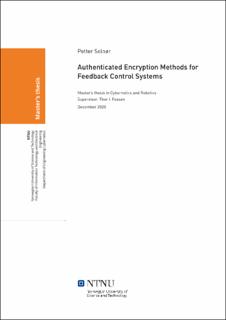| dc.description.abstract | Tilbakekoplingssystemer krever at signaler sendes mellom sensorer, tilstandsestimatorer, regulatorer og aktuatorer. Disse signalene er sårbare for tyvlytting, som gjør at uautoriserte aktører kan få kjennskap til potensielt konfidensielle system- og regulatorparametre gjennom systemidentifikasjon. Uautoriserte aktører kan også manipulere komponenter i tilbakekoplingssystemet ved å manipulere signaler og sende inn falske signaler. Dersom en uautorisert aktør klarer å kapre et slikt system, for eksempel et ubemannet fartøy, kan det få katastrofale materielle og økonomiske følger dersom det kaprede fartøyet benyttes som et verktøy i et terrorangrep eller i en krigshandling. Sikring av signalene i et tilbakekoblingssystem er derfor svært viktig.
For å sikre signalene i et tilbakekoblingssystem kan vi benytte oss av kryptografiske verktøy. Selv om noe forskning er publisert på dette fagområdet tidligere, har forskere brukt eldre, og tidvis utdaterte, algoritmer. Måtene de kryptografiske algoritmene har vært benyttet på har også vært mangelfulle, noe som har gjort at mange av forslagene er svært sårbare for angrep. I denne avhandlingen analyserer vi tidligere forslag og implementerer angrep som viser sårbarhetene. Angrepene demonstrerer at de tidligere forslagene gjør at systemene lekker informasjon og fører til tap av konfidensialitet, og også gjør det mulig å forfalske signaler og dermed manipulere systemet. Som et alternativ, foreslås derfor kryptografisk sterke metoder som ikke er sårbare for disse angrepene.
For å implementere de foreslåtte kryptografiske metodene blir en verktøykasse med moderne kryptografiske algoritmer utviklet. Ytelsen til algoritmeimplementasjonene blir deretter målt ved å måle tidsforsinkelsen til ulike mengder data på industrielle Raspberry Pis. I tillegg diskuteres synkroniseringsmetoder og trafikkekspansjon som er viktig. Resultatene viser at implementasjonene av moderne flytchiffer har bedre ytelse og gir mindre tidsforsinkelser enn tradisjonelle blokkchiffer. Implementasjonene gir svært små tidsforsinkelser, godt under 1 millisekund for mindre datamengder, og egner seg derfor svært godt for sanntidssystemer. | |
| dc.description.abstract | Feedback control systems require that signals are transmitted between sensors, state estimators, controllers, and actuators. These signal transmissions enable adversaries to eavesdrop on the signals that are transmitted to conduct system identification, potentially revealing system parameters and control parameters that may be considered confidential. Worse yet, an adversary could potentially alter messages or inject spoofed messages to manipulate the behavior of the controller, state estimator, or actuator to gain control of the system. The hijacking of a dynamical system, for example, an Unmanned Surface Vehicle (USV), can result in catastrophic material and economic consequences if used to inflict damage as part of a terrorist attack or as an act of war. Therefore, securing the signal transmission in feedback control systems is of great importance.
We may accomplish this through the use of cryptographic tools. While some research has been conducted in this area in the past, the research that has been published has consisted of ciphers that are not optimal by modern standards, both concerning security and performance. The cryptographic algorithms have also been used in insecure ways, thus enabling attacks. In this thesis, the previously proposed schemes are analyzed, and attacks are implemented. The attacks demonstrate that the previously proposed schemes leak information and even enable the injection of forged messages, contrary to the claims of the authors. This thesis attempts to improve on the work that has been published by bringing in modern, cryptographically sound techniques. A scheme that is cryptographically strong, and not vulnerable to the demonstrated attacks, is then proposed.
To implement the proposed scheme, a toolbox containing high-performance implementations of state-of-the-art cryptographic algorithms is developed. The algorithm implementations are benchmarked for considerations such as the latency that is induced by processing various amounts of data. Other important aspects, such as synchronization mechanisms and traffic expansion, are also treated. The experiments are conducted on industrial Raspberry Pis in an encryption laboratory setup that was built as part of previous project work. The Raspberry Pis are used to ensure that the results obtained are relevant in an industrial setting in which embedded devices are more likely to be present than powerful desktop machines. The results show that the state-of-the-art stream cipher implementations outperform traditional block ciphers. Furthermore, the algorithms induce very little latency, less than a millisecond on small amounts of data, and are therefore well-suited for real-time applications. | |
